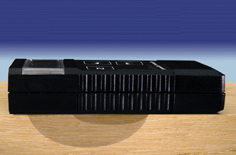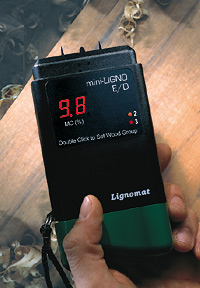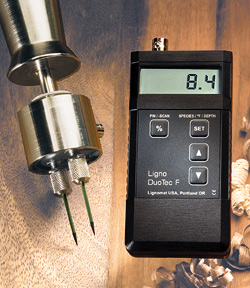
I still remember my first moisture meter. Twenty-five years ago, I bought a mini-Ligno handheld model for about a hundred dollars and immediately ran around sticking the pins into every piece of wood in grabbing distance. This, I concluded, is one of the coolest toys ever, and I could justify it because it actually performed a vital service: telling me when boards were dry enough for me to build with them.
My original is long gone, but the E/D version I own now is more accurate, easier to use, and sells for about the same price as my original did. For that reason among others, Lignomat is regarded by many as the premier handheld moisture meter company in the U.S., and the darling of both professional and hobby woodworkers. In fact, they’ve been leading the field with their mini-Ligno almost since the handy devices first arrived on our shores.
In a sense, the American side of the Lignomat story starts with Robert Hildebrand. He owned an engineering company in Germany that made kilns and the control systems to go with them. His son-in-law and daughter, Ulrich and Grete Heimerdinger, came to the U.S. in 1975 in order to start a branch of the company here. While Ulrich concentrated on selling kiln control systems, Grete started her own company in 1981 offering the mini-Ligno.
“The inexpensive handheld moisture meter Grete chose to introduce was made by a German company called Lignomat,” explained their daughter, Martina, the marketing manager for the family owned company. “That company was started about f45 years ago by Horst Klinkmueller. My mother started off with 100 mini-Lignos and began contacting people in the woodworking field to see if they needed a moisture meter. At the time, she knew little about woodworking, having been a math and physics teacher in Germany.”
“I started selling at woodworking shows,” Grete recounted, taking over the story for her daughter, “and got a lot of interest immediately. That’s because the mini-Ligno is affordable, durable, reliable and accurate. In fact, it was the first small, affordable, handheld moisture meter for woodworkers introduced to North America. Though we started with woodworking shows, these days we sell through woodworking stores like Rockler, through online venues like Amazon.com, and directly from our web site.
“When I first arrived here people would ask me ‘why do I need a moisture meter?’ I told them if the wood is not properly dried it will shrink, move or warp and may very well destroy what you build. The challenge of woodworking starts with choosing the right lumber. If the wood is not right, even the best tools and craftsmanship can’t guarantee a quality product.
“Once we started selling the mini-Ligno, a ton of immediate positive feedback came in about the tool’s efficacy, simplicity and durability. I feel very comfortable selling these and telling people it is a good product. It is accurate, keeps its calibration and is comfortable to use. Some people have even told me they never had to change the batteries in five years. In short, it is the ideal tool for hobby, small shop and professional woodworkers.”
Once Grete realized what a good product it was, she went even further. “In 1985, we bought the rights to the mini-Ligno from the German company who made it,” Grete explained, “and started assembling them here in Oregon using German-made parts. We’re still a small, family-owned business, with everything assembled, sold and supported from one facility in Portland, Oregon. However, we sell all over. In fact, we now sell the mini-Ligno back to the German Lignomat company, who list it on their web site and sells it in Europe.
“We also offer more intricate meters in addition to the mini-Ligno, with more calibrations and a wide range of optional equipment for monitoring the lumber inside kilns and the kilns themselves. We sell both pin type, in which two tiny pins are stuck into the wood to read the moisture content, and pinless meters that do not make holes in the wood. There’s even a model called the Versa-Tec which works as either a pinless or pin type.
“While pinless meters do not make holes in the wood, they are substantially more expensive and are generally a bit less accurate than pin type. That’s because pin meters read water content directly by measuring electrical resistance, which varies depending on the moisture in the wood. Pinless meters measure electrical capacity, and it changes with the specific gravity of the wood. Granted, more moisture means a higher specific gravity, but it can also mean the wood is denser in that spot. Hence, with a pinless meter you can get a higher reading than the amount of moisture would warrant.
“Naturally, pinless meters are better for reading finished pieces where you don’t want damage in the form of two tiny holes, but that doesn’t generally concern woodworkers. They read wood before they build, and use the meter in an area that will be cut or sanded away. When I say holes, we are talking about two holes under a millimeter in diameter, 25 millimeters apart and about five to 10 millimeters deep.
“For most hobby woodworkers, the mini-Ligno E/D model is the best entry-level moisture meter. It covers a wide range of moisture content, (from 6 to 45 percent) has a digital readout, is comfortable, extremely easy to use, and retails for just over a hundred dollars. There are two sets of pins provided for two different depth readings. The deeper ones, which store inside the case, are for thicker lumber to get a more accurate core reading. This particular model has been sold for two years, and we’ve never gotten one returned.
“For professionals, I usually suggest the DX/C, which has settings for a larger variety of species, including many exotic woods. You can also plug in a slide hammer electrode that allows even deeper readings. Another option is to hook up any of a wide variety of in-kiln probes of different sizes and lengths to get accurate readings while wood is being dried.
“The range in calibration settings is one of the things that differentiates various models. For instance, the E/D has two calibration setting options. The model K has more than 120 settings. A card comes with each model listing the various wood species and tells you which calibration to read each one on.
“Perhaps the biggest challenge as far as research goes is keeping track of new woods that show up on the market for which we don’t yet have a calibration. As part of our customer service, we encourage our customers to send us a sample of whatever wood they are using and we will test it, for free, and tell them what setting to use. I do it by reading the wood on a meter with 20 different calibrations. I take at least nine readings, weigh the wood, dry it until it contains zero moisture, weigh it again, and calculate the moisture loss. That tells me what the meter should have read, and consequently which setting on the meter was the appropriate one. Of course, you can do that yourself, but we are happy to do it for you. If we do it, we add the wood permanently to our list of woods, as we did not long ago when Lyptus® came on the market.
“Personally,” insists Grete, “I think every woodworker should have a moisture meter. You should always check your lumber before you use it, especially if you buy from places like box stores. Those stores may buy lumber that is kiln dried, but storage on-site can send it off the ideal range. A lot can happen, even if it was initially dried, before you get it. That is why people need a moisture meter, and for the money, we feel ours is the best one on the market.”








